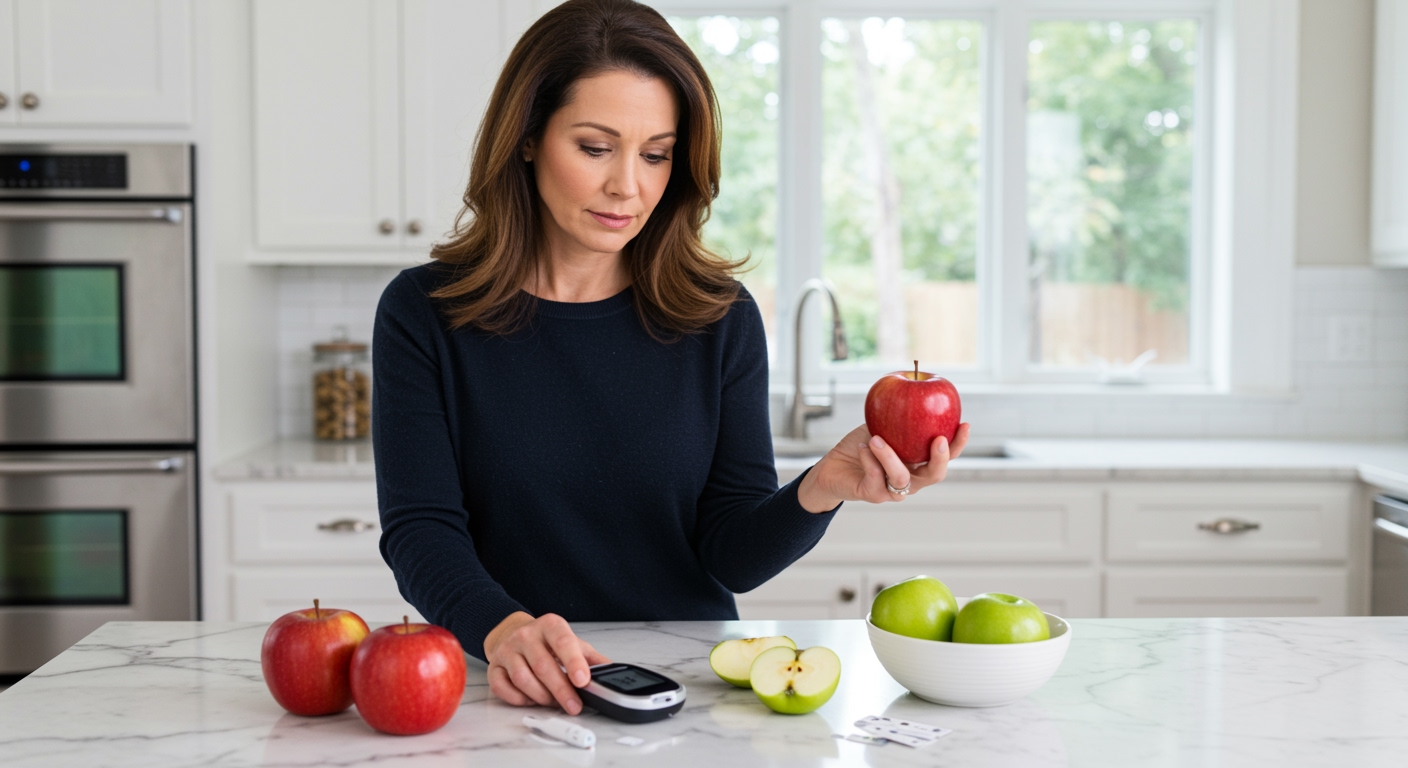✪ Key Takeaway: Apples are generally safe for diabetics when eaten in moderation due to their fiber content and moderate glycemic index.
Introduction
You reach for an apple at the grocery store, then suddenly stop and wonder if this sweet fruit will send your blood sugar through the roof.
This hesitation happens to millions of people with diabetes who struggle to balance their love for nutritious foods with their need to control glucose levels.
Hi, I’m Abdur, your nutrition coach and today I’m going to explain exactly how apples affect your blood sugar and whether you can safely include them in your diabetes management plan.
Do Apples Raise Blood Sugar Levels?
Apples do raise blood sugar levels, but the increase is moderate and manageable for most people with diabetes.
A medium apple contains about 25 grams of carbohydrates, which your body breaks down into glucose during digestion.
However, apples have a glycemic index of 36, which places them in the low-glycemic category.
This means apples cause a slower, more gradual rise in blood sugar compared to high-glycemic foods like white bread or candy.
The fiber content in apples plays a crucial role in this slower glucose response.
One medium apple provides about 4 grams of fiber, which slows down the absorption of sugar in your intestines.
This fiber acts like a natural speed bump for glucose, preventing the sharp spikes that can be dangerous for diabetics.
✪ Fact: The skin of an apple contains most of its fiber, so always eat apples with the peel on for maximum blood sugar benefits.
What Makes Apples Different From Other Fruits?
Apples stand out from other fruits because of their unique combination of fiber, water content, and natural compounds called polyphenols.
Unlike tropical fruits such as pineapple or mango, apples contain less concentrated sugars and more structural fiber.
The pectin in apples is a special type of soluble fiber that forms a gel-like substance in your stomach.
This gel slows down the movement of food through your digestive system, giving your body more time to process the sugars gradually.
Research shows that the polyphenols in apples may actually help improve insulin sensitivity over time.
These natural compounds can help your cells respond better to insulin, which is especially beneficial for people with type 2 diabetes.
The high water content in apples also helps you feel full without adding extra calories, making them an excellent choice for weight management alongside diabetes control.
✪ Pro Tip: Choose tart apple varieties like Granny Smith over sweet ones like Red Delicious for better blood sugar control.
How Should Diabetics Eat Apples Safely?
Portion control is the most important factor when including apples in a diabetic diet.
One medium apple (about the size of a tennis ball) is considered an appropriate serving size for most people with diabetes.
Eating apples with protein or healthy fats can further slow down glucose absorption and provide better blood sugar stability.
Try pairing apple slices with a small handful of nuts, a tablespoon of almond butter, or a piece of cheese.
The timing of when you eat apples also matters for blood sugar management.
Eating an apple as part of a balanced meal rather than as an isolated snack helps minimize blood sugar spikes.
Always avoid apple juice or processed apple products, as these lack fiber and cause rapid glucose spikes that whole apples do not.
✪ Note: Monitor your blood sugar 2 hours after eating an apple to understand your personal response to this fruit.
Are There Any Risks For Diabetics?
Most diabetics can safely enjoy apples, but certain situations require extra caution and monitoring.
People with gastroparesis, a diabetes complication that slows stomach emptying, may experience unpredictable blood sugar responses to apples.
The fiber in apples can sometimes worsen digestive symptoms in people with this condition.
If you take insulin or diabetes medications, eating apples without adjusting your medication timing could lead to blood sugar fluctuations.
Always consult with your healthcare provider about incorporating new foods into your diabetes management plan.
Some people may experience higher blood sugar responses to apples due to individual metabolic differences or insulin resistance levels.
Regular blood glucose monitoring helps you understand how your body specifically responds to apples and adjust your eating patterns accordingly.
✪ Pro Tip: Keep a food diary tracking your blood sugar responses to different apple varieties and eating combinations.
The Bottom Line
Apples can be a healthy and safe addition to most diabetic diets when consumed mindfully and in appropriate portions.
The key to managing diabetes is not avoiding nutritious foods, but learning how to include them wisely in your daily routine.
I would love to hear about your experiences with apples and diabetes management, so please share your thoughts, questions, or personal tips in the comments section below.
References
At NutritionCrown, we use quality and credible sources to ensure our content is accurate and trustworthy. Below are the sources referenced in creating this article:
- Healthline: Apples and Diabetes: What You Need to Know
- Signos: Are Apples Good for Type 2 Diabetes?
- Medical News Today: Diabetes and Apples: Benefits, Nutrition, and Other Fruits
- Diabetes Care Community: 10 Low Glycemic Fruits for Diabetes





